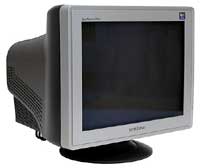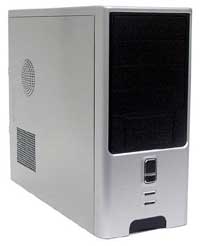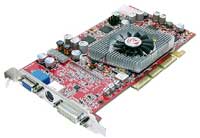AMD Budget Gaming System
If price is your biggest concern, then even $25 for a slightly faster component can be "too much". Such increases add up quickly, and that's what makes this the most difficult price goal to achieve without making compromises. In fact, it really isn't possible to build a "Budget" system that doesn't make some concessions to the almighty dollar. We have done our best, however, to build a system that will be capable of playing all the latest titles at acceptable rates for the next year or two at least. We have a couple of options from the AMD camp as well as one from the Intel side to help you out. We'll start with the absolute cheapest system that we would recommend for gaming, and follow that with a slightly updated system.
| Budget AMD Athlon 64 754 System |
| Hardware |
Recommended Component |
Price |
| Processor |
AMD Athlon 64 2800+ 512K 1.8 GHz (754) |
127 |
| Motherboard |
Chaintech VNF-250 (754) |
73 |
| Memory |
1x512MB Mushkin Basic 2.5-4-4 |
75 |
| Video Card |
Sapphire Radeon 9800 Pro 128 MB 256-bit |
196 |
| Hard Drive |
Seagate Barracuda 80GB EIDE model 7200.7 |
59 |
| Optical Drive |
NEC DVD+/-RW Drive Model 3500A |
72 |
| Case and Power Supply |
Athenatech A602 Black/Silver with 350W PSU |
62 |
| Display |
Samsung 793DF 17 Black/Silver CRT (1280x1024@75 Hz) |
139 |
| Speakers |
Use what you have |
0 |
| Keyboard and Mouse |
Logitech Optical Desktop Combo |
26 |
| Bottom Line |
|
829 |

Click to enlarge. |
The final price comes to a bit more than our $750 target. Unfortunately, it is difficult to get a quality gaming system without making some compromises. We don't include speakers either, on the assumption that most people will have some decent headphones or speakers already available. The same can be said of the monitor: if you already have a monitor with which you are content, you can stick with that for the time being. One nice feature of our Samsung is that it can provide a generally flicker-free 75 Hz refresh rate at its highest 1280x1024 resolution. Unless you need a complete system, those items are the prime candidates for reducing the cost to reach the $750 goal.

Click to enlarge. |
Keyboard and mouse are a personal choice, but we have stuck with the bare minimum for the time being. We prefer Microsoft and Logitech keyboards and mice for a variety of reasons, but they are certainly not the only option; so if your opinion differs from ours, get what you like. The case was one of the more difficult items to select. We like Antec cases for their quality and overall reliability, but there are a huge number of cases from which to choose, so we wanted to give some other options. The Athenatech case comes with a generic 350W PSU, but that will suffice for this configuration. It also has a rear 120mm fan and a cooling duct that sits above the CPU, allowing the HSF to draw in fresh, cool air directly.

Click to enlarge. |
The real core of any gaming system is not the case, speakers and monitor. Those are what others will see, and they may be important from an aesthetic point of view, but if you're only worried about games and you're on a budget, the motherboard, processor, and graphics card are where you want to spend the most money. The socket 754 platform may not have the long-term upgrade options of socket 939, but it does allow us to cut about $50 off the price without sacrificing a whole lot of performance. We have chosen the cheapest Athlon 64 available, the 2800+, which runs at 1.8 GHz. Performance in games is generally better than the Pentium 4 2.8 GHz chips, so the performance rating is deserved. The Sempron 3100+ is also an option that would save us another $20 or so, but we felt that the potential 64-bit enhancements, which should arrive in the next year or so, make it worthwhile, not to mention the larger 512K cache.

Click to enlarge. |
Our choice of graphics card goes to the Radeon 9800 Pro 128 MB. It is important to emphasize that we're looking at the version with a 256-bit memory interface, so make sure you choose the correct model if you want to remain with our selection. There are "9800 Pro" cards now shipping with 128-bit interfaces, and there are also the 9800SE cards that have lower clock speeds and half of the pixel pipelines. For gaming performance, there's almost a linear scaling with the amount of money spent on your graphics card these days. So, if you are willing to turn down some details, you could go with one of the other 9800 variants or even the 9600 Pro or 9600XT, but they are likely to have some issues with upcoming games within the next year or so. For this price bracket, it is also worth mentioning that the 256 MB cards are mostly pointless unless you have a 256-bit memory interface, and that combination tends to cost quite a bit more. If the difference in price between a 128 MB and a 256 MB card is relatively small - i.e. less than $25 - then a card with more RAM might be useful. Otherwise, save your money.
The remainder of the system is pretty much what you've seen us recommend in the past. The 80GB Seagate hard drive comes with a five-year warranty and provides ample storage. Performance differences between the various hard drives really are not that great unless you really spend a lot of money. The DVD+RW drive is our Editor's Choice NEC 3500A from the recent
Fall 16X DVDR Roundup, which provides good performance and features at a very low price. We could have gone with a cheaper optical drive instead of a DVD burner, but we prefer to have a system with CD/DVD burning capability. If you disagree, a DVD-ROM drive can be had for about $25, as can a CD-RW drive. We recommend DVD support for gaming systems, as some of the newer titles are shipping in both DVD and CD versions. Installing from one DVD is much more convenient than installing from four or more CDs, and we can only hope that more games will make the shift to DVDs. We did not include a floppy drive, but for an extra $9, you might want to toss one in just to be safe. There are still some hard drive controllers that require the use of a driver floppy in order to work with the Windows XP installation.














70 Comments
View All Comments
spartacvs - Wednesday, January 5, 2005 - link
I decided to wait and I'll most probably go for nforce4. One thing I reallly like about your guide is the fact that there is many budgets. Most of the guides provides 3 systems (budget, price/performance and power) but more systems is really helpfull.Careless Joe - Tuesday, January 4, 2005 - link
RE: the "Cheap" psu in the budget case. Its a re-badged fortron. Very reliable.JarredWalton - Saturday, December 4, 2004 - link
Just FYI, I recently upgraded from the integrated audio on my MSI K8N Neo Platinum to an Audigy 2 ZS. My benchmarks in Half-Life 2 (using a measley 9800 Pro) went up a whopping 1 FPS. It might matter more with a faster GPU, but for my setup the sound card didn't matter much. It did, however, eliminate some static/noise from the audio. I couldn't hear it on the speakers, but on headphones it was very noticeable.Was it worth $75? That depends on how much disposable income you have and how annoying any extra static is. Since I often use headphones on my PC at night (no need to wake the wife and neighbors), it was annoying enough for me that I went and spent the money. For most people - particularly those using moderate to cheap speakers - you probably wouldn't notice.
SDA - Saturday, December 4, 2004 - link
Jarred, very true.. I've seen people defend PowerStream purchases after being told that they're the same as Tagans (which I don't do, by the way; I hate to even implicitly insult something that someone else owns) by saying that OCZ is a good name and is better-recognized, as if that really has anything to do with PSU performance. If you ask me, I don't think that sort of thing should really be factored into recommendations.. if someone wants to pay more for a brand name (when it has been demonstrated that there's no functional advantage), they're probably in the minority. (If someone wants to pay more for the PowerStream's looks, they need 20ccs of taste, stat. .. kidding, PowerStream owners ;)Oh, and spartacvs, just remember that integrated audio (non-SoundStorm integrated audio, anyway) will eat more CPU than a dedicated sound card will. It's not much of a big deal with today's overpowered PCs, if you ask me, and you still get plenty of bang for your buck (infinite bang for your buck, actually, since integrated audio is free).
spartacvs - Friday, December 3, 2004 - link
JarredWalton, yes, I think I understand your argument: AGPat the end of his life and PCIe is comming in.I had bad information about integrated audio. Integrated audio is not fantastic but I'm sure it'll be a majhor improvment over my old sb live!value 4.1... And, as I said, it's a way to save a few dollars. Something I, unfortunately, have to be very cautious these days :(
Thank you very much for your wise comments.
JarredWalton - Friday, December 3, 2004 - link
SDA - I understand that the internals are the same. For some people, however, the outside (and the brand) will matter. It doesn't bother me much, but convincing others of this is more difficult to do. I always prefer the weight test for PSUs (assuming you're at a store where you can pick up the PSU). All things being apparently equal, always go with the heavier PSU. :)Spartacvs - *all* motherboards include integrated audio these days. What Nforce4 doesn't include is the SoundStorm audio that was in Nforce1 and Nforce2 (certain models). NVIDIA is supposed to be working on a high-definition audio solution, but when that will actually arrive is a little difficult to say. The audio that will be on Nforce4 is the same as what is on most Nforce3 boards these days, so don't worry too much about that. If audio is really important to you, pick up a Creative Audigy 2 ZS (for games) or the M-Audio Revolution 7.1 (for more serious audio work).
SDA - Friday, December 3, 2004 - link
That depends on your definition of close, Jarred ;) The only real differences between them are cosmetic (shell, sticker, brand). The components, layout, and design are nearly identical.If you're having trouble with this concept, here's a parallel for you: Alienware's older notebooks (before they switched to Uniwill) and equivalent Sager notebooks (with a comparable configuration, obviously). Same platform, same layouts, same chassis, same components (possible that they used different brands of memory or something, but that's about it), same party assembling them; the differences are almost entirely cosmetic, and the ones that aren't don't apply to functionality.
Hopefully this is all a little clearer now, the world of computer hardware is really far too convoluted for its own good..
spartacvs - Thursday, December 2, 2004 - link
Ok, thanks for you answer. The place I want to buy have most of the memory brands. It's just muskin, they have only a few models.As for the MB. What I don't like about nforce4 is the lack of integrated audio. It increase the price tag a little bit more and I'm tight on money :(
JarredWalton - Thursday, December 2, 2004 - link
SDA - Just pointing out that they're not identical. Close, perhaps, and which you like more is probably more a matter of preference, but they certainly aren't identical.Spartcvs - Corsair, GEIL, Kingston, OCZ, and quite a few others are decent RAM. For value RAM, Kingston and Corsair are probably the most widely spread, but I don't really know what other countries are like in terms of availability. The difference between the motherboards is more difficult to quantify. I really like Abit boards, but I'm not as keen on the VIA chipset - NVIDIA just seems more stable in my experience. Either one is still a fine motherboard, and there are several other socket 939 NForce3 250 boards available. Now, though, waiting for NForce4 non-SLI might be a good idea - get one of those for ~$130 and get a 6600GT PCIe card.
spartacvs - Thursday, December 2, 2004 - link
Hey guys, I have a few questions.Fisrt, I do not overclock my system and will most probaly go with the Antec 2650 case because it's smaller and still a good case. Will also take the 120 GB HD because 160 is overkill for me (hey I hardly fullfill my actual 40 GB).
I hesitate between the abit board and the msi one. What do I lose going for the abit rather than the msi? The Abit is a via chipset, right?
Where I want to buy they don't have much of the mushkin memory. Can you recommand another brand (and model please because there is so many type of memory modules, it's easy to be lost).
Thanks